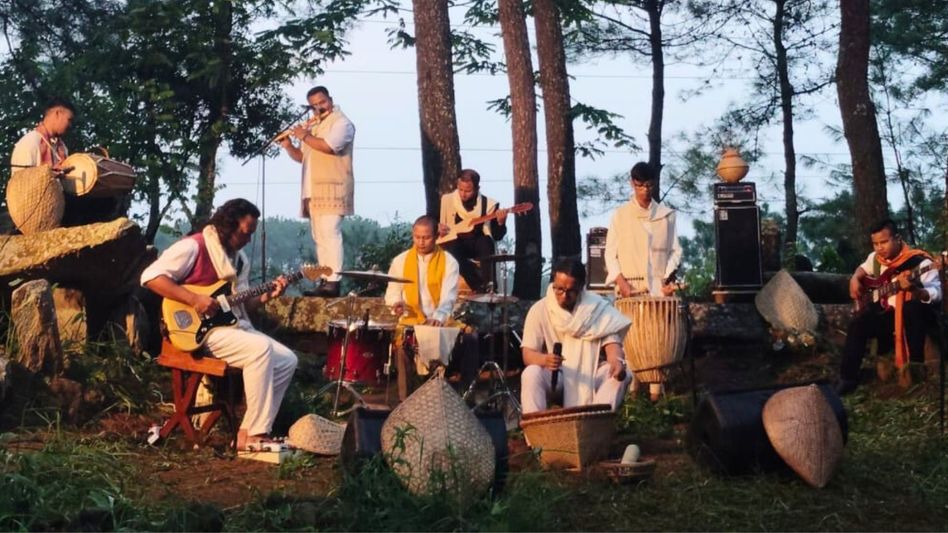
Recording with the ancestors: Da Minot’s songs of stone and soul
Da Minot’s music uniquely blends ancestral themes with soulful storytelling, preserving cultural heritage. Their compositions inspire listeners by connecting past traditions with present emotions

Most bands rent studios. Meghalaya’s Da Minot rents history.
Their latest track wasn't recorded in some padded room with fancy equipment. It was captured live among ancient standing stones at Iewrynghep, where merchants once hawked their wares centuries ago. No second takes. No fixing mistakes later. Just eight musicians, their instruments, and stones that have been watching the world change for longer than anyone can remember.
"The version you hear is one single take. No overdubs. What we played at the ancient ruins of the first market of the erstwhile HIMA SHYLLONG is what we put out," says Hammarsing L Kharhmar, who plays about half the instruments in this collective and seems to think about music the way philosophers think about existence.
Sound of waterfalls, gusts of wind, and birds having their own conversations. Normal people hear background noise. Musicians hear a full orchestra. In Meghalaya, where Da Minot operates, nature doesn't just provide scenery; it provides the soundtrack.
The name game
"Da Minot can be translated from Khasi into English as 'To Persevere' or 'With Perseverance'. It's a name that is meant to inspire, not only us, but others too," Hammarsing explains. Easy to pronounce, easy to remember, hard to forget once you've heard what they do.
But here's the thing about their perseverance: it's not aimed at Billboard charts or Spotify playlists. "As a band, we are not bound or driven by popularity or monetary factors," Hammarsing admits. "However, we know our art is very specific, and its audience as of now is very small."
So why keep going? "We all sense that what we're creating together is not just for the present but also for future generations, for them to create and grow from."
The usual suspects
The Da Minot lineup reads like a small army: Hammarsing (lyrics, guitar, bass, percussion), Priyo Laloo (lyrics, vocals, duitara), Dajied Sing Kharkongor (traditional drums, duitara, tangmuri), Marwan Rymbai (flute, nakra, backing vocals), Swissco Sunn (traditional drums), Phistonwell Khongji (bass), Airailang Kharakor (traditional drums), and Melvyn Kharumnuid (drums, percussion).
But wait, there's more. "Da Minot in some ways is much more than a band," Hammarsing notes. Behind the scenes: filmmaker Sankirang L Khongwir, who Hammarsing describes as "not only highly gifted and intelligent. He is fully committed to preserving and sharing indigenous culture and traditions." Then there's Sukdor Kharakor, handling logistics and location scouting like some kind of cultural archaeologist.
They're connected to Syrwet U Barim, an organisation working to preserve Khasi-Jaintia cultural landscapes. This isn't their side hustle; it's their main mission wearing a band costume.

The soul business
"Da Minot is firmly rooted in the Khasi Soul," Hammarsing explains. But what does that mean when you're trying to reach people who might not know where Meghalaya is on a map?
Take their approach to the sun. Most of the world thinks masculine when they think solar power. Khasi worldview goes feminine: "Ka Mei Syiem Sngi, which literally translates as, Queen Mother Sun. Or simply as Mei Ngi (Mother Sun). The Sun gives light and, therefore, life. Invoking the Sun as a Mother is very meaningful in my opinion."
Their lyrics do not even belong to them, technically. "To be very honest, we don't feel it's right to list ourselves as the lyricists. Not because we have stolen anything. But simply because what we sing has been in existence in this land since time immemorial. They are born of the Hynñiewtrep, which to us signifies something deeply spiritual."
Timing found voice
"Spah Mynsiem" took almost twenty years to finish. Hammarsing composed the main guitar riff during his first semester at Berklee College of Music in Boston. It sat around like that friend who crashes on your couch and never leaves, waiting for the right moment.
That moment came during a rehearsal when vocalist Priyo Laloo heard it, recorded it on his phone (because that's how music happens now), and came back with lyrics and melody. The bridge with the title was added just a month before release.
Originally called "Ka Nongkylliang", a Khasi concept that sort of means karma but not really, the song found its final form through what Hammarsing calls "the right time." "Like all things, there is a uniquely Khasi understanding or teaching that translations can never do justice to."

Stone Cold Recording
The standing stones at Iewrynghep aren't just pretty rocks. They're witnesses to the first market of the Hima Shillong, a traditional Khasi state that once stretched from the Umngot River south to the Brahmaputra valley north, Kupli River east to the Umtrew River west. Nongkseh was its original capital before British colonisation chopped it into smaller pieces.
"Those stones are witnesses to the history of humankind. When you think about or imagine the people, the scenes, and the events that have taken place in such locations, the entire place begins to feel different. The stones feel alive."
The weather almost ruined everything. "We were very fortunate it didn't rain that day, despite forecasts predicting stormy weather. However, it did drizzle very slightly, but this didn't disturb the session. It added to the mood and influenced the way we performed."
Recording engineer Banbha Sawkmie captured everything in one take, then mixed it. No do-overs, no fixing the drummer's timing, no autotune. What happened, happened.
The anti-AI manifesto
"In today's world where AI is churning out songs and artists are obsessed with editing their music to sound perfect, I believe a band like ours, that plays music live, together, aiming to capture an emotion, a picture of time, a feeling felt together as one, is more necessary now, than ever before," Hammarsing argues.
This is their rebellion: actual humans playing actual instruments in actual places that matter.

Sacred sites, not tourist traps
"We always pick a place of historical, cultural, and spiritual significance. In all cases so far, all three aspects are embodied in one," Hammarsing explains. These aren't Instagram photo ops. "We don't choose these sites only for their incredible beauty. We understand that shooting and recording in these sacred sites through music and videos is a great way of sharing and drawing interest to the rich heritage of the Hynñiewtrep (Khasi-Jaintia people), particularly the youth."
"In today's world, where physical books aren't being read as much as before, using digital mediums to share and highlight indigenous wisdom, stories, and art forms is not only extremely effective, it is vital and necessary."
The fusion question
How do you mix traditional Khasi instruments with modern ones without creating some weird world music nightmare? "If you respect the traditional and derive inspiration from it, things eventually fall into place," Hammarsing says. "The modern instruments are meant to exist alongside and strengthen the traditional elements."
The secret sauce: understanding that it's not about the instruments themselves but how they're played. "Khasi instruments are very similar to those found in other parts of India and beyond. However, it is the way they are played that makes them distinctly 'Khasi'."
Hammarsing particularly loves Dajied Sing Kharkongor's duitara playing on "Spah Mynsiem," comparing it to late Khasi music legend Rgh Kerius Wahlang. High praise in a scene where legends aren't made lightly.
The June 21 tradition
Both "Spah Mynsiem" and their previous release, "Ri Shongpdeng Pyrthei", dropped on World Music Day. Accident? "The release of Ri Shongpdeng Pyrthei on World Music Day was a coincidence. But, it makes a lot of sense to release music on this day."
More importantly, it creates a deadline. "It also serves as a target which ensures we finish songs in progress within a timeframe." Nothing like ancient market ruins and a calendar date to force creative decisions.

The movement
"A cultural movement has already been set in motion. Da Minot is a small part of it," Hammarsing observes. They have noticed young people getting interested in their subject matter, "beginning to do their studies and explorations. This, to me personally, is the greatest reward and matters more than any grand recognition."
The goal isn't world domination. It's cultural preservation through digital means, reaching people who might never read a book about Khasi philosophy but will watch a music video.
Global Khasi
For listeners outside Meghalaya or India, Da Minot offers a crash course in seeing the world differently. "We want listeners to be interested in the world, stories and beliefs we sing about. We hope our songs inspire listeners to find out more about the 'Khasi Worldview', which I believe has much to offer the world, especially in spiritual terms."
Hammarsing's advice to young musicians: "Persevere but don't forget to have fun! Learn as much as you can about the world around you, and especially about your own. Don't be afraid to keep asking questions. Keep reaching forward and within! There is no end to learning."
Copyright©2025 Living Media India Limited. For reprint rights: Syndications Today









